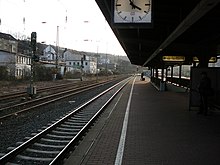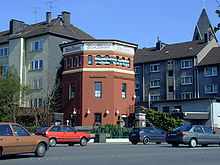Wuppertal-Steinbeck train station
| Wuppertal-Steinbeck | |
|---|---|
 Reception building entrance
|
|
| Data | |
| Location in the network | Intermediate station |
| Platform tracks | 2 |
| abbreviation | KWS |
| IBNR | 8006619 |
| Price range | 5 |
| opening | 1841 |
| Profile on Bahnhof.de | Wuppertal-Steinbeck |
| location | |
| City / municipality | Wuppertal |
| Place / district | Steinbeck |
| country | North Rhine-Westphalia |
| Country | Germany |
| Coordinates | 51 ° 15 '4 " N , 7 ° 8' 24" E |
| Height ( SO ) | 172 m above sea level NHN |
| Railway lines | |
|
|
| Railway stations in North Rhine-Westphalia | |
The Wuppertal-Steinbeck train station is a former train station and is now a stop on the Düsseldorf – Elberfeld railway line in the Elberfeld district of Wuppertal . The former station building was built in 1913 and has been a listed building since July 29, 1991 ; it replaced an older one that was built between 1860 and 1870.
history
Private railway
In 1841 the Düsseldorf-Elberfeld railway line of the Düsseldorf-Elberfelder Eisenbahn-Gesellschaft was opened as one of the first in western Germany. Due to the topographical conditions, the railway line ended here about one kilometer before the Elberfeld city center at the boundary of the old Steinbeck farm . First a not very representative reception building for the terminus was built there.
A few years later, the Elberfeld – Dortmund railway was built by the Bergisch-Märkische Eisenbahngesellschaft from Dortmund, which in turn ended initially on the other side of Döppers Berg . On December 28, 1848, the mountain breakthrough took place, which connected the two railway lines, enabled a continuous connection in the valley of the Wupper and converted Steinbeck into a through station . The Elberfeld train station built in the cut already took over the function of the most important Elberfeld passenger train station from 1849.
The station building was erected between 1860 and 1870, at the same time extensive freight railroad areas as well as a marshalling yard , open loading tracks and a railway depot with turntable and circular shed segments were set up on the spacious site , as Elberfeld station offered no space for this.
Prussian State Railways
In the course of the next few years, Steinbeck station lost its importance compared to the more centrally located Elberfeld station, just under a kilometer away, and lost most of the stops for national trains. With the construction of the Burgholzbahn in 1891, Steinbeck became a separation station .
Beyond a bridge over the tracks at the station, today's Wuppertal Südbrücke , the station's water tower was built, which, after its original use was abandoned, temporarily served as a restaurant.
The four-track expansion of the railway line took place by 1914. This was accompanied by a major redesign of the station area, the round shed was replaced by a rectangular structure. The station building was also replaced by today's representative building in 1913.
German Reichsbahn
The darkest chapter in the history of the station lies in the later phase of the Nazi era : the deportation of over 1000 Jewish citizens of Wuppertal via Eastern European ghettos to the Nazi extermination camps took place from Steinbeck station. On the platform, an inscribed stone obelisk commemorates the five mass transports that took place.
During the air raids on Elberfeld , the station building was severely damaged, the hipped roof with the round gable over the entrance area and the clock tower in the center were not rebuilt.
Deutsche Bundesbahn or Bahn
In the 1980s, the station was further restricted in its importance with the expansion of the S-Bahn network and the general dismantling measures. The loading of goods and the marshalling yard were completely abandoned; the extensive track system was largely built over with commercial space and the “Steinbecker Meile” shopping center .
In the second half of the 20th century, the quarterly transports of conscripts from the Wuppertal district military service to the places of their basic military service started in Steinbeck . The material transported by rail from the units of the Wehrmacht , the British armed forces and the German armed forces stationed in the Wuppertal barracks throughout history was also loaded in Steinbeck.
Due to the optimization of the long-distance tracks, a platform was eliminated without replacement at the end of the 20th century and after the shutdown of the Burgholzbahn, since May 29, 1988, only the S8 S-Bahn stopped at the station stepped up to the stop. Since December 15, 2003, the newly created S9 S-Bahn line was added, which is the successor to the N9 and RB49 lines . A staircase leads from the south bridge to the platform.
At the beginning of the 21st century, the discussion was about developing the southern part of the station area as the Mediapark Wuppertal project and locating media companies there. In 2006 these plans were dropped. The station building, which was placed under monument protection in 1991, was extensively renovated in 2007 and given a redesigned roof floor. In addition to companies, a large organic supermarket uses the building.
Depot
In 1914, a new depot (Bw) was built at the western end of the station, which replaced the previous systems directly opposite the station building. It was designed as a rectangular shed with an internal sliding platform, on the eastern side there was a turntable.
Between 1953 and 1955 the depot was converted into a diesel depot, the first in the Wuppertal Federal Railway Directorate. The turntable has been removed. The transfer platform was also expanded, so that all shed tracks were given external entrances.
In 1992 the time ended as an independent department of the Wuppertal depot and the depot was under the Cologne 2 depot until it was closed at the end of the 20th century . In 2002 the time as a branch also ended, the locomotives were serviced in the Cologne Gremberg depot . In 2015 the locomotive shed was demolished and the locomotive line is to be sold to a subsequent user. The former sub-camp and the former signal box 2 are under monument protection.
In the times of steam locomotives, the series 38, 55, 56, 64, 74, 78, 86, 92 and 94 were stationed here. From 1934 diesel railcars were also added. V 36 also came here after the Second World War. In 1953 the first Uerdingen rail buses were stationed here, initially only the VT 95, from 1959 also the VT 98. After the V 60 and the V 100, the V 90 were also stationed here, as well as small locomotives and tower cars and other work vehicles.
See also
literature
- Ralf Händeler: Sad finale in Steinbeck . In: railway magazine . No. 10 , 2015, ISSN 0342-1902 , p. 48-50 .
Web links
NRWbahnarchiv by André Joost:
- Description of the Wuppertal-Steinbeck train station
- Description of the KWS office
- Description of the KWS G
further evidence:
- Entry in the Wuppertal monument list
- Steinbeck train station
Individual evidence
- ↑ Querying the course book route 485 at Deutsche Bahn.
- ↑ Ralf Händeler: Sad finale in Steinbeck . In: railway magazine . No. 10 , 2015, ISSN 0342-1902 , p. 49 .


